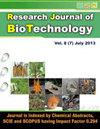The Potential of Pseudomonad fluorescens Secondary Metabolites to inhibit Ralstonia solanacearum Bacterial Wilt Disease
IF 0.2
Q4 Biochemistry, Genetics and Molecular Biology
引用次数: 0
Abstract
This study aims to determine the ability of Pseudomonad fluorescens isolates Pf-122 and Pf-142 secondary metabolites against R. solanacearum pathogen in vitro and in vivo. The study used a two-factor factorial experiment with RAL design and the observed data were analyzed using the Least Significant Difference (LSD) of 5%. The first factor was the type of isolate of Pseudomonad fluorescens: P1 (Pf-122) and P2 (Pf-142). The second factor was the concentration of the secondary metabolites: K1 (10%), K2 (20%) and K3 (30%), so six treatments were done and repeated five times. The in vitro results indicated all treatments could weakly inhibit R. solanacearum development indicated by the small inhibition zone. This may be due to the presence of siderophore antibacterial compounds; pioverdin, pioluteorin, HCN and phenazine. This study observed the largest inhibition zone in P2K3 treatment (Pf-142, 30%). The in vivo antagonist test indicated that all treatments could suppress bacterial wilt disease. The disease index was 0% for 4 weeks of observation while it reached 57.33% in control.荧光假单胞菌次生代谢物抑制茄枯萎病菌的潜力
本研究旨在确定荧光假单胞菌分离物 Pf-122 和 Pf-142 次生代谢物在体外和体内抗茄属葡萄孢病原体的能力。研究采用 RAL 设计的双因素因子实验,观察数据采用 5%最小显著性差异(LSD)进行分析。第一个因素是荧光假单胞菌的分离物类型:P1(Pf-122)和 P2(Pf-142)。第二个因素是次生代谢物的浓度:K1 (10%)、K2 (20%) 和 K3 (30%),共进行了六次处理,重复五次。体外试验结果表明,所有处理都能微弱地抑制茄碱菌的生长,抑制区很小。这可能是由于苷类抗菌化合物(pioverdin、pioluteorin、HCN 和 phenazine)的存在。本研究观察到 P2K3 处理的抑制区最大(Pf-142,30%)。体内拮抗剂试验表明,所有处理都能抑制细菌性枯萎病。在 4 周的观察中,病害指数为 0%,而对照组的病害指数为 57.33%。
本文章由计算机程序翻译,如有差异,请以英文原文为准。
求助全文
约1分钟内获得全文
求助全文
来源期刊

Research Journal of Biotechnology
工程技术-生物工程与应用微生物
CiteScore
0.60
自引率
0.00%
发文量
192
审稿时长
1.5 months
期刊介绍:
We invite you to contribute Research Papers / Short Communications / Review Papers:
-In any field of Biotechnology, Biochemistry, Microbiology and Industrial Microbiology, Soil Technology, Agriculture Biotechnology.
-in any field related to Food Biotechnology, Nutrition Biotechnology, Genetic Engineering and Commercial Biotechnology.
-in any field of Biotechnology related to Drugs and Pharmaceutical products for human beings, animals and plants.
-in any field related to Environmental Biotechnolgy, Waste Treatment of Liquids, Soilds and Gases; Sustainability.
-in inter-realted field of Chemical Sciences, Biological Sciences, Environmental Sciences and Life Sciences.
-in any field related to Biotechnological Engineering, Industrial Biotechnology and Instrumentation.
-in any field related to Nano-technology.
-in any field related to Plant Biotechnology.
 求助内容:
求助内容: 应助结果提醒方式:
应助结果提醒方式:


